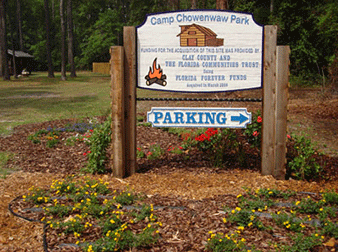A wood stork silently wades shallow waters like a drum major in slow motion. Bill submerged, its great dark head sweeps back and forth across shallow, murky waters. Look closely, because this dramatic wading bird is endangered. Its significant decline symbolizes the magnitude of environmental threats stalking today's Everglades. River of Grass was the description affixed to this gently sloping landscape in the 1940's by pioneering conservationist Marjory Stoneman Douglas. Within the park this river still flows slowly towards bay and gulf. Its grandeur is now severely threatened, however, and the death of the Everglades could occur. This is still the first national park created to protect a threatened ecological system.
Visitor Centers
Make your first stop in the park at one of its four visitor centers. The staff can help you plan the best use of your time and answer questions about park facilities and activities. Informative publications are sold at the visitor centers.
 |
| Boardwalk |
Best Way to Visit
The best way to visit the park is to take time to walk the boardwalks and trails along the main park road and to join in ranger-led events. Naturalists give talks and lead hikes, canoe trips, tram tours, and campfire programs. At Everglades City the
Gulf Coast Visitor Center is the park's western saltwater gateway. Narrated boat tours explore the pristine Ten Thousand Islands and coastal mangrove. At
Shark Valley the wildlife-viewing tram tour through sawgrass prairie includes a stop at a 65 foot tower for spectacular views. Birds and alligator viewing rank among the park's best here.
Walking Trails
Experience the diversity of Everglades environments by walking short, wheel-chair-accessible trails from parking areas throughout the park. At
Royal Palm the
Anhinga Trail, a 1/2 mile loop trail, offers one of the best opportunities to view wildlife, including alligators and birds up close. The
Gumbo Limbo Trail, a 1/2 mile loop, winds through a jungle-like tropical hardwood hammock reshaped by Hurricane Andrew in 1992. Along the main park road the
Pinelands Trail, a 1/2 mile loop, explores a subtropical pine forest maintained by fire. The pinelands are the most diverse land habitat in south Florida. At
Pa-hay-okee Overlook a 1/2 mile boardwalk leads to an observation tower offering a panoramic view of the River of Grass. A 1/2 mile boardwalk at
Mahogany Hammock crosses the Glades and loops through a subtropical tree island with massive mahogany trees. The
West Lake Trail, a 1/2 mile boardwalk, loops deep into a forest of salt-tolerant, prop-rooted mangrove trees. At
Flamingo's Eco Pond a short walk leads to a wildlife-viewing platform. At
Shark Valley the
Bobcat Boardwalk, a 1/4 mile walk from the visitor center, loops through sawgrass prairie and a bayhead. At
Otter Cave a one-mile round trip from the visitor center enters subtropical hardwood hammock.
Camping
Long Pine Key and
Flamingo campgrounds offer drinking water, picnic tables, grills, restrooms, dump-stations and tent and trailer sites. Coldwater showers only are available at Flamingo, fees are charged in winter. Recreational vehicles are permitted, but there are no electrical, water or sewage hookups. Wilderness camping permits are required for all backcountry sites and are issued no more than 24 hours in advance; fees are charged seasonally.
Nature Man Photography is pleased to bring you the following:
 |
| Crocodile at Flamingo Campground |
 |
| River of Grass |




























